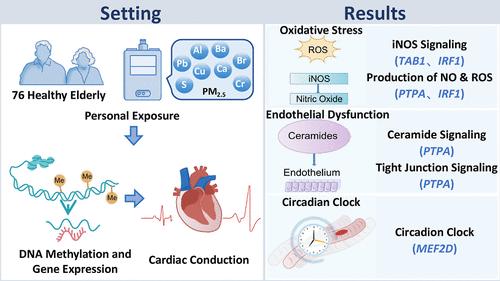老年人心脏传导中PM2.5化学成分的分子图谱:多组学研究
IF 11.3
1区 环境科学与生态学
Q1 ENGINEERING, ENVIRONMENTAL
引用次数: 0
摘要
环境细颗粒物(PM2.5)暴露对心血管风险有充分的证据,然而,关于老年人心脏传导的潜在机制,特别是纵向影响的证据有限。我们的目标是确定PM2.5中与心脏电生理异常、DNA甲基化介导的途径以及与基因表达的复杂相互作用相关的关键有毒无机元素成分。采用混合暴露模型分析348例健康老年人PM2.5及其无机化学成分与心电图参数的关系。通过表观基因组分析和双向中介分析,探讨表观遗传变化的影响模式。进行综合分析以确定潜在的生物学途径。混合暴露模型表明,S和Pb是QRS持续时间和QTc间隔延长的主要因素。双向中介分析结合高维中介分析发现,43个胞嘧啶-磷鸟嘌呤位点(CpGs)显著介导PM2.5、Pb、S与ECG参数的关联,约90%的位点表现出较弱的反向中介作用。Cis-eQTM分析显示PM2.5和S元素相关的dmp可调节下游基因表达,影响心电参数。具体来说,四个CpGs及其注释基因表达(HMBOX1、C1orf109、ATAD3A和RINL)对这些关联显示出一致的影响,共同涉及多种途径,包括抗原呈递、神经酰胺积累和昼夜节律。这项研究表明,整合表观基因组和转录组谱可能为心血管疾病的临床治疗提供环境起源和有前途的生物标志物的新见解。本文章由计算机程序翻译,如有差异,请以英文原文为准。

Molecular Atlas of PM2.5 Chemical Constituents on Cardiac Conduction: A Multiomics Landscape in Older Adults
Ambient fine particulate matter (PM2.5) exposure is well-documented for cardiovascular risks, however, limited evidence regarding the underlying mechanisms on cardiac conduction in the elderly, especially regarding longitudinal impacts. We aimed to identify key toxic inorganic elemental constituents in PM2.5 linked to cardiac electrophysiological abnormalities, DNA methylation-mediated pathways and the complex interplay with gene expression. The associations of PM2.5 and its inorganic chemical constituents with electrocardiography (ECG) parameters were analyzed in 348 measurements of the healthy elderly by mixture exposure models. Epigenomic analyses and bidirectional mediation analyses were conducted to explore the effect patterns of epigenetic changes. Integrated analysis were performed to identify the potential biological pathways. Mixture exposure models identified S and Pb as major contributors to prolonged QRS duration and QTc interval. Bidirectional mediation analysis combined high-dimension mediating analysis revealed 43 cytosine-phosphoguanine sites (CpGs) significantly mediated the association between exposure to PM2.5, Pb, and S and ECG parameters, with about 90% showing weaker reverse mediation. Cis-eQTM analysis showed that PM2.5 and S elements associated DMPs modulated downstream gene expression, influencing ECG parameters. Specifically, four CpGs and their annotated gene expressions (HMBOX1, C1orf109, ATAD3A, and RINL) showed consistent effects on these associations, collectively involving multiple pathways, including the antigen presentation, ceramide accumulation, and circadian rhythm. This study elucidates that the incorporation of integrated epigenomic and transcriptomic profiles may provide novel insights into environmental origins and promising biomarkers for the clinical treatment of cardiovascular diseases.
求助全文
通过发布文献求助,成功后即可免费获取论文全文。
去求助
来源期刊

环境科学与技术
环境科学-工程:环境
CiteScore
17.50
自引率
9.60%
发文量
12359
审稿时长
2.8 months
期刊介绍:
Environmental Science & Technology (ES&T) is a co-sponsored academic and technical magazine by the Hubei Provincial Environmental Protection Bureau and the Hubei Provincial Academy of Environmental Sciences.
Environmental Science & Technology (ES&T) holds the status of Chinese core journals, scientific papers source journals of China, Chinese Science Citation Database source journals, and Chinese Academic Journal Comprehensive Evaluation Database source journals. This publication focuses on the academic field of environmental protection, featuring articles related to environmental protection and technical advancements.
 求助内容:
求助内容: 应助结果提醒方式:
应助结果提醒方式:


